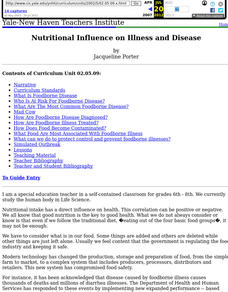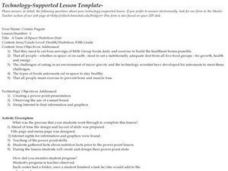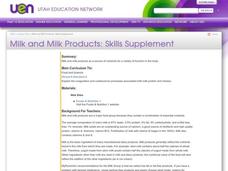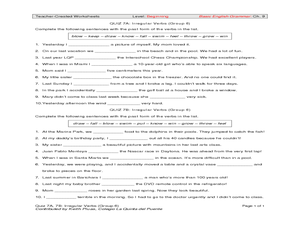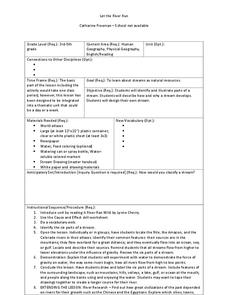Curated OER
Agriscience
Students research and write a paper on any agriscience related topic. In this series of agriscience lesson, students create a presentation to teach their peers about the animal industry. They explain the uses and importance of...
Curated OER
Nutritional Influence on Illness and Disease
Students examine nutritionally related diseases and illnesses, evaluating studies and developing topics for a science fair project. They investigate bacteria, researching how it can be harmful or helpful, and create illustrated displays.
Curated OER
Nutrients
Fourth graders discuss whether they ate breakfast and if so, did their breakfast contain all that their body needs until lunch time. They talk about the definition of nutrients and that every part of their body needs water. They also...
Curated OER
A Taste of Space Nutrition Unit
Second graders make a power point presentation about space nutrition and health.
Curated OER
Milk and Milk Products: Skills Supplement
Explain the coagulation and coalescence processes associated with milk protein and cheese. List the components of milk and explain how each component is dispersed in the milk. Describe what happens when milk protein is coagulated Discuss...
Curated OER
Defining Culture
Students explore cultural diversity. In this cultural awareness lesson, students examine the similarities and differences in various cultures and discuss the value of these differences.
Science Teachers
Organ Systems Crossword Puzzle
An attractive and informative body systems crossword plus its answer key is provided for your life science learners. The topic is the organs. With 23 prompts to address, they are sure to get a complete review in identifying the systems...
Curated OER
Benefits of Indoor Plants
Young scholars diagram a plant. In this Science lesson plan, students explore the concept of photosynthesis focusing on the oxygen production. Young scholars calculate the amount of plants needed to filter the air in their classroom.
Curated OER
Irregular Verbs
Divided into two 10-question exercises, this worksheet provides practice with irregular verbs in the simple past tense. Ten present-tense, monosyllabic verbs are given in a word bank; learners write the past tense form in a blank in each...
Curated OER
2nd Grade - Act. 25: Creature Creation
Create a creature using some of the characteristics of a real animal. Second graders will read a book from the "Froggy," series by Johnathan London to learn about the characteristics of frogs. After discussing and recording various...
Curated OER
Gluten and Balloons What Do They Have In Common?
Students examine the purpose of gluten in bread making and what type of flour is needed to make bread. They compare the properties of a balloon to bread dough to explain yeast fermentation. They make bread.
Curated OER
Canine Companions
Students identify the responsibilities of being a dog owner. In this animal welfare lesson, students list ten important items that a dog needs to live and visit a pet store to calculate the total cost of the items. Students visit a local...
Curated OER
Vary Your Veggies and Focus on Fruits
Third graders study a healthy diet. In this healthy diet lesson, 3rd graders investigate the nutritional value of fruits and vegetables. Students compare a healthy diet to their personal diet.
Curated OER
Habitat Mural
Students build a collage of an ecosystem. The goal is for them to understand interactions in a community, plant and animal adaptations, and how all life depends on plants. This activity is based on Wump World and students describe what...
Curated OER
Living On Earth
Students discover the many different animals within various habitats and discover how each individual species interacts with its particular environment. Through charting different animals and their distinct habitat and matching animals...
Curated OER
Ready for Roots
Fourth graders sort seeds and predict what conditions are needed for them to germinate. They keep the seeds moist, observe and measure their growth and graph the results. As the seeds start to grow students compare and contrast the each...
Curated OER
Understanding Waves
Young scholars examine the physical properties of waves to explore the word crest and trough. They use toys to study waves in air, water and light.
Teacher Vision
The Wampanoag Indians: A Thanksgiving Lesson
Spark some lively conversation about American holiday traditions and debunk accepted notions about the first Thanksgiving at the same time. After reviewing the mainstream version of the Thanksgiving story with your class, offer some...
Curated OER
Let the River Run
Students explore the environment by reading a story in class. In this water formation lesson, students define environmental terms such as rivers, streams, gulf, oceans and lakes. Students read the story A River Ran Wild and discuss the...
Curated OER
Essential Nutrients - Daily Guides
List the recommended dietary guidelines and explain their function and implementation. (The guidelines are listed below) National Standards 14.3.1 Aim for fitness Aim for a healthy weight Be physically active each day
Curated OER
Ziplock Chemistry
Students investigate various chemical reactions when creating mixtures in ziplock baggies. In this chemistry lesson, students will recognize various chemical reactions and cite evidence. Safety and assessment strategies are included in...
Curated OER
Hermit Crabs in the Classroom
Students interact with hermit crabs in the their classroom. In this hermit crab lesson, students handle and observe hermit crabs while learning about their habitats and how to treat animals. They watch how the animals move and answer...
Curated OER
Animal Signs
Learners discuss the many different types of animal signs that can be used to identify and track animals. They participate in an hands-on activity in which they examine tracks, trails, homes, territory markings, and even "scat" left by...
Curated OER
Soil Permeability
Young scholars discuss how soil permeability is affected by permafrost. In this soil lesson plan, students freeze soil over night, and discuss how the environmental conditions of freezing affect soil and further affect vegetation.



